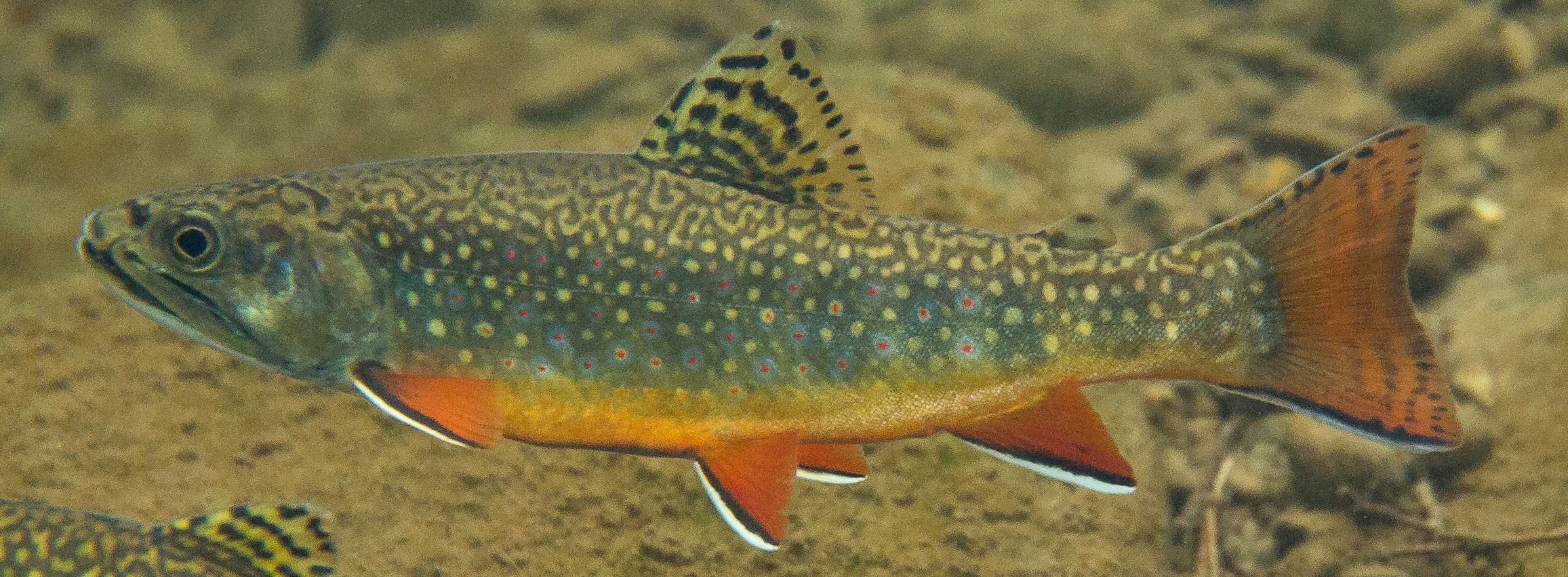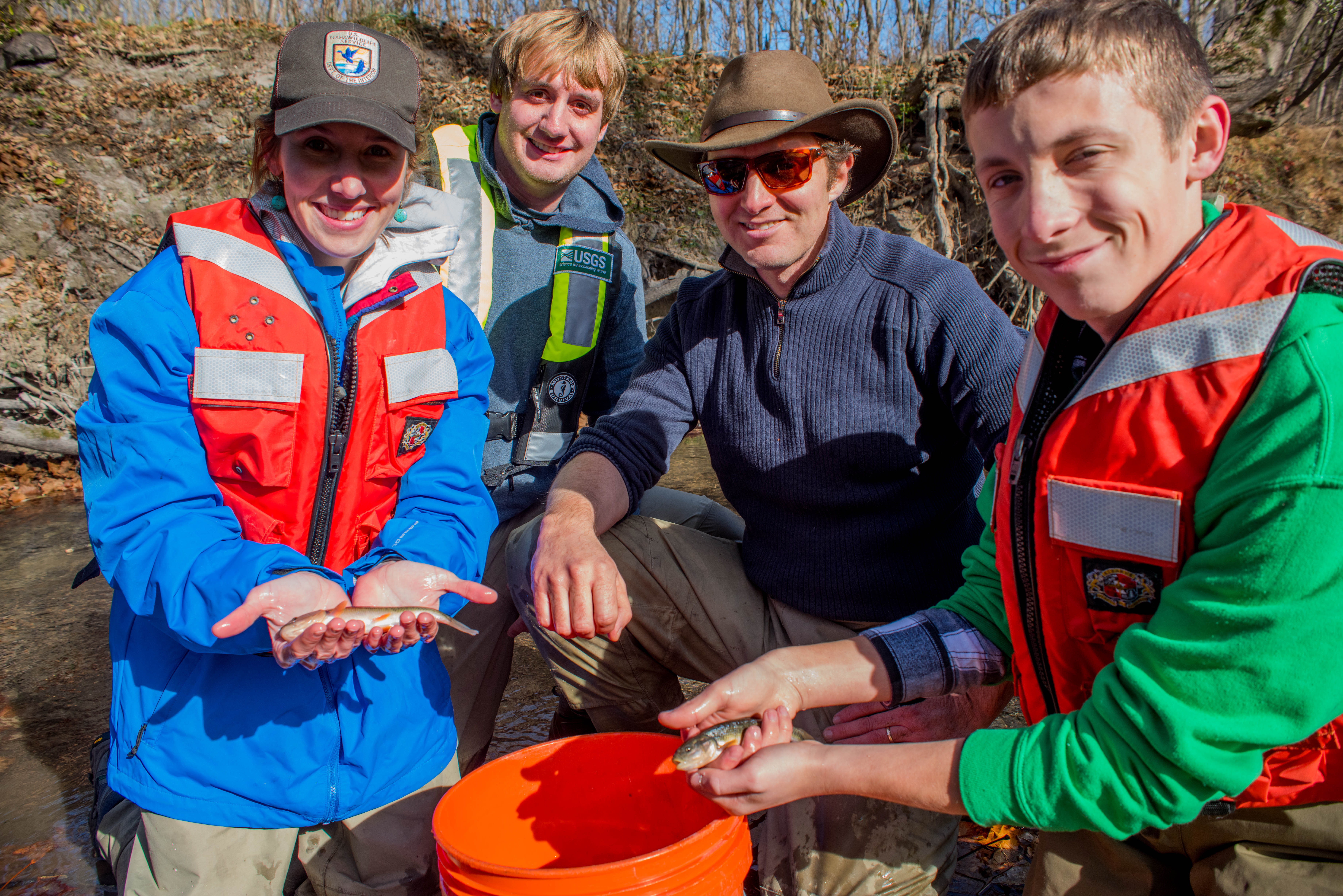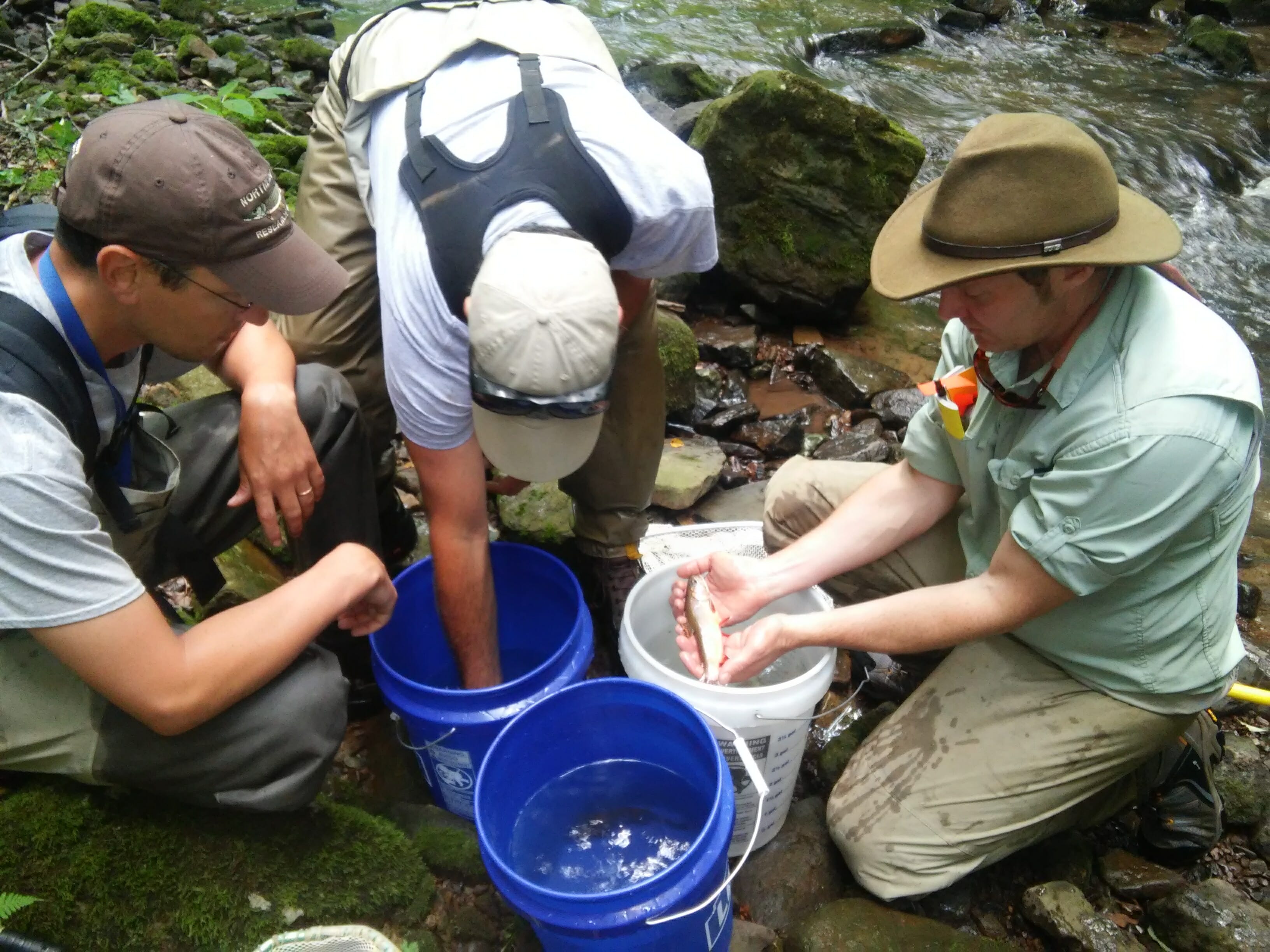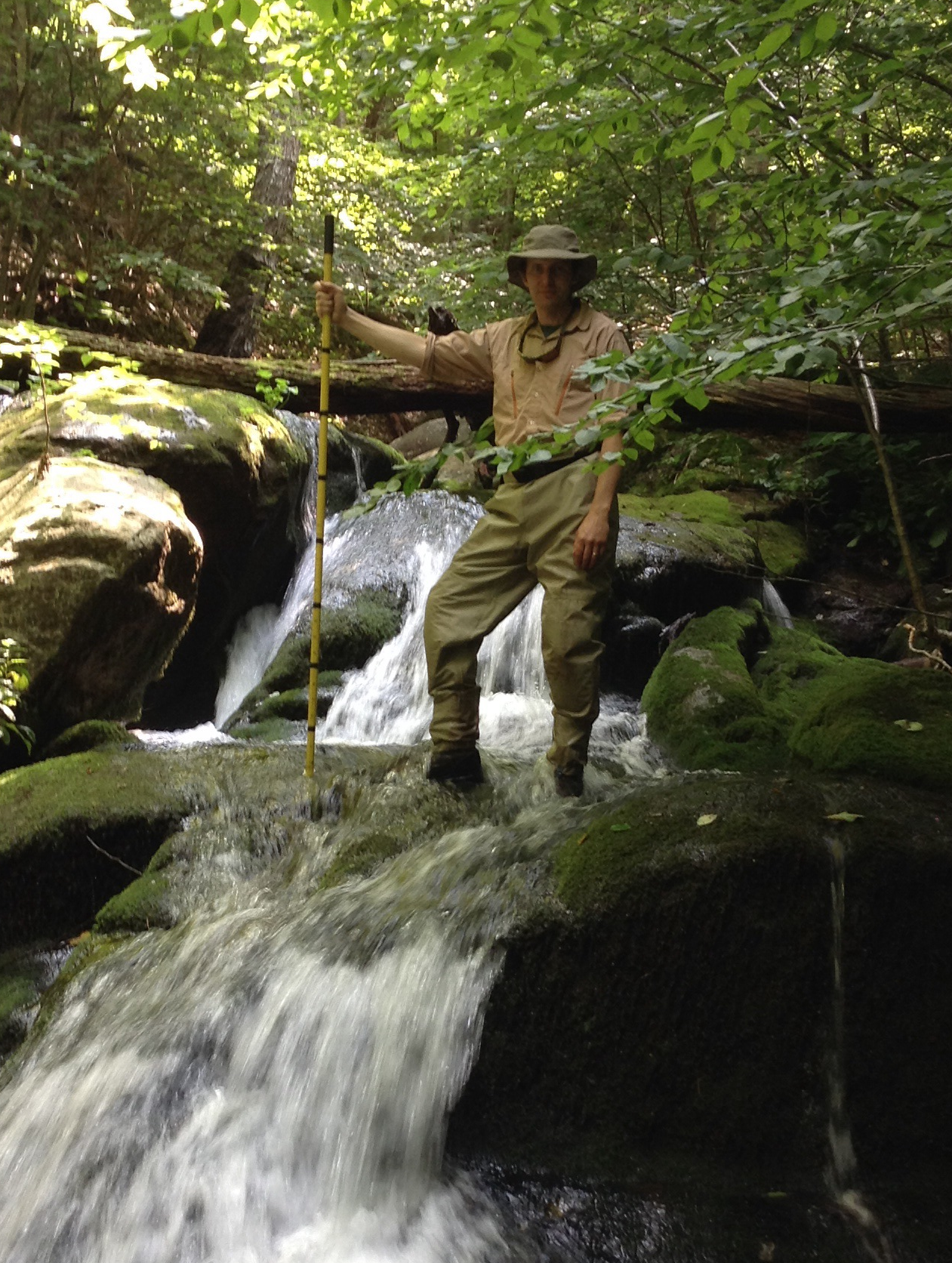USGS fish biologist Than Hitt during stream assessment work in Shenandoah National Park, in Virginia.
The summer issue of Trout Unlimited’s Trout magazine that is hitting mailboxes now is full of stories that feature innovative work by TU employees, volunteers and partners.
TU’s vice president of eastern conservation, Keith Curley, recently caught up for a Q&A session with a scientist who is spearheading groundbreaking brook trout-related research in the East.
Nathaniel “Than” Hitt is a research fish biologist with the U.S. Geological Survey based at the USGS’s Leetown Science Center in Kearneysville, W.Va. His research investigates freshwater fish ecology and community ecotoxicology from a landscape perspective, focusing on stream ecosystems in the Appalachian highlands. His research includes:
-
Modeling fish habitat and population/community responses to environmental change
-
Forecasting effects of climate change for fish habitat in headwater streams
-
Effects of stream flow and temperature on population dynamics of fish communities
Hitt holds a B.A. in Biology from the College of Wooster, an M.S. in Organismal Biology and Ecology from the University of Montana, and a Ph.D. in Fisheries and Wildlife Sciences from Virginia Tech.
Please describe your work on brook trout.
I’m trying to understand how native brook trout respond to changing environmental conditions. It’s a fascinating species because they can thrive under many different environmental conditions – lakes, streams and rivers, even marine environments – but their numbers are declining across their native range, particularly in the southern Appalachian Mountains.

Ryan Haggerty, USFWS
Of course their temperature requirements are well known, but we still have a long way to go to understand how temperature interacts with other stressors on the landscape such as drought and floods. I’m using various approaches to address this, including an experimental stream laboratory, stream habitat and fish population assessments, and statistical modeling techniques.
How did you get into brook trout research?
I grew up hiking and fishing the West Virginia highlands, so the mountains here are second nature to me. After graduating from the College of Wooster in Biology, I worked for a forest conservation non-profit in Ohio where it became evident to me that (1) people really care about clean water and fishing, and (2) I needed some technical chops if I was going to make a difference.
So I made my way to the University of Montana where I studied conservation genetics of westslope cutthroat trout with Chris Frissell and Fred Allendorf. I then went to Virginia Tech to study fish ecology with Paul Angermeier for my PhD program. That work led me to the US Geological Survey’s Leetown Science Center in West Virginia, where I’ve developed a research program addressing fish population and community ecology, including work on native brook trout. Also, luck probably had something to do with it.
You’ve done some innovative work on fine-scale climate modeling. Tell us about what you’ve learned from that work, and what the implications are for brook trout conservation.
We’ve learned that Appalachian mountain streams have much more dynamic thermal habitat for fish than previously thought. That’s because shallow groundwater aquifers move water into and out of stream channels creating a mosaic of thermal habitat for fish.
My research group has developed new techniques to rapidly assess groundwater effects from stream temperature data, and we’ve put this to use for trout habitat forecasting in National Parks and Trout Unlimited priority areas.
 Although we expect groundwater to buffer warming trends to some degree, this will depend on the depth of the aquifer and winter recharge dynamics – and we’re developing on new methods to predict this across landscapes.
Although we expect groundwater to buffer warming trends to some degree, this will depend on the depth of the aquifer and winter recharge dynamics – and we’re developing on new methods to predict this across landscapes.
We’re also investigating how groundwater upwelling promotes brook trout larval development and recruitment. In our experimental stream laboratory research, we’ve also learned that brown trout outcompete brook trout for feeding locations as temperatures increase. So, although we may not be able to limit warming conditions, we can help brook trout persist by managing their competitors.
How has citizen science played a role in your work?
It’s clear we can’t rely solely on river gage data to tell us about trout habitat in the headwaters. Instead, we need networks of temperature and flow data at many locations – and this is where I see a huge opportunity for citizen science.

Than Hitt (holding fish) during brook trout assessment field work with a crew from the Maryland Department of Natural Resources.
Last year we launched a pilot project for trout habitat assessment with Trout Unlimited in the Shenandoah Valley in Virginia. USGS focused on the sampling design and analysis, and TU volunteers deployed and collected the gages.
We then used those data to forecast future trout habitat conditions and reported back to TU volunteers with a webinar presentation. Of course, this is a two-way street: We’re not just providing results, but we’re learning from the on-the-ground experience of TU volunteers to help us improve our statistical models. I think this is an exciting model that could be expanded nationwide.
What have you learned through your work on brook trout movement, and how do you see that influencing brook trout management and conservation?
We found that brook trout seek out cold groundwater upwelling zones when ambient temperatures exceed 20 degrees C (68 F). That temperature also corresponds to the onset of physiological stress in brook trout, so we think this is a real ecological threshold to consider in conservation planning.
We’ve also found that native brook trout populations can show very different movement rates and habitat use preferences when held under common conditions. Moreover, those differences can’t be explained by body size, sex ratio, or density-dependent competition. Instead, they could indicate differences in local adaptation to site-specific conditions across different streams.
If so, this means that different populations are irreplaceable if lost, and that hatchery fish cannot be expected to make up for wild populations. However, we need to evaluate the offspring of these wild fish populations to isolate genetic effects from possible acclimation effects (i.e., phenotypic variation), and that work is on-going.
What are the most exciting future opportunities you see for research on coldwater fisheries?
 We’re starting to link research across levels of biological organization – genes, behavior, population dynamics, community interactions – to better understand ecological resiliency.
We’re starting to link research across levels of biological organization – genes, behavior, population dynamics, community interactions – to better understand ecological resiliency.
For instance, I’m working with others at the Leetown Science Center to understand how genes express heat-shock proteins in warming environments – and whether different native trout populations show different patterns.
We’re also evaluating how these individual fish respond to changes in overhead cover and food availability, and linking this work to our habitat and groundwater assessment research.
Looking ahead, a key challenge will be to parse what matters most for trout population viability and to apply it for conservation of the places we care about – and this challenge will increase as “big data” and new linkages expand.
But the rapid pace of new insights and increasing community involvement also gives me optimism for trout conservation, and I appreciate the opportunity to contribute to this important effort.



